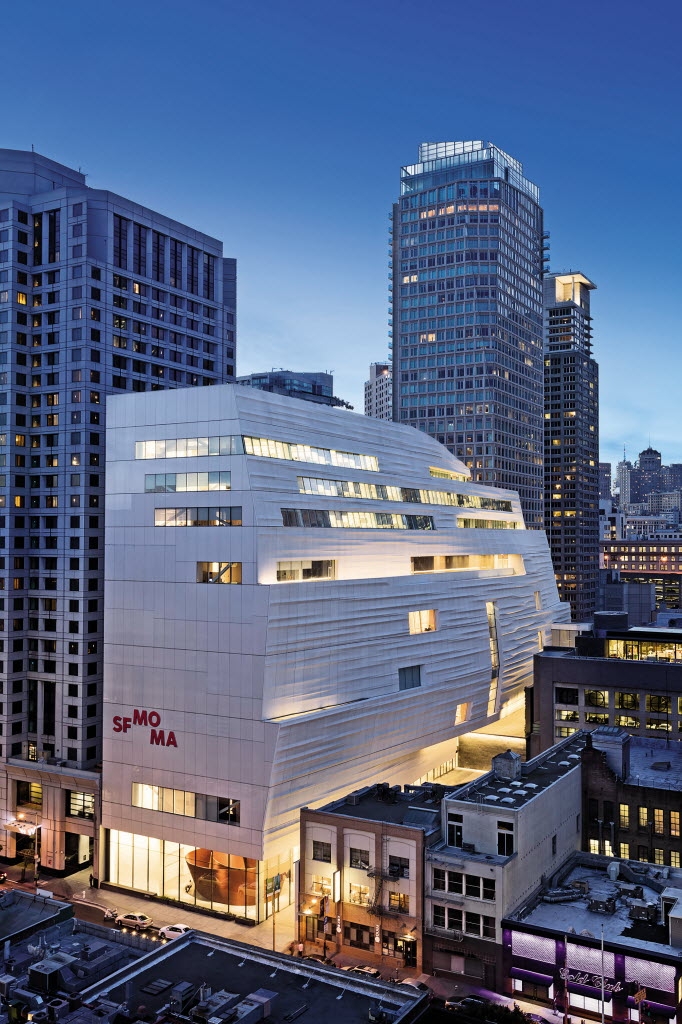April 12, 2016 Updated 4/12/2016
Email Print

San Francisco Museum of Modern Art photo by Henrik Kam The San Francisco Museum of Modern Art uses composites covering 77,000 square feet of the exterior to give it a distinctive look.
The ripple-faced panels on the facade of the San Francisco Museum of Modern Art simulate the water in nearby San Francisco Bay.
“The facade panels are the largest architectural application of composites technology in the United States and the signature architectural feature of the museum’s new building,” said Bill Kreysler, president of panel fabricator Kreysler & Associates Inc.
The fiber-reinforced-polymer panels are one of the most visible features of the dramatically expanded museum, which reopens May 14. The project took almost three years to finish and involved experimenting with materials, textures, finishes and designs.
The panels cover 77,000 square feet of the exterior with 710 uniquely shaped wave-depicting ones on the east and west elevations and another 700 smaller flat panels filling in areas about windows, doors and soffits. The larger panels measure up to 5.5 feet high with widths of 6-30 feet.
SFMOMA was founded in 1935 and, in 1995, moved into its first purpose-built home that was designed by Mario Botta and occupies 225,000 square feet. The 10-story expansion adds 235,000 square feet adjacent to the renovated Botta building.
SFMOMA selected international architectural firm Snøhetta AS of Oslo, Norway, for the project in September 2010. Kreysler & Associates used Rhino computer-aided-design software for 3-D modeling, Autodesk Inc.’s Delcam PowerMill computer-assisted-manufacturing software for tool path and motion control, Autodesk’s Revit software for building information modeling, a computer-numerical-control hotwire machine for initial shaping and then two five-axis Motion Master CNC gantry routers for machining.
The FRP panels weigh about 3.5 pounds per square foot and avoid the need for an intermediate steel frame. The panels are attached to curtain-wall aluminum frames.
In contrast, glass-fiber-reinforced concrete panels would have weighed about 15 to 20 pounds per square foot and the steel support framing would have added about 15 pounds per square foot.
Polynt Composites USA Inc. of Carpentersville, Ill., formerly CCP Composites, provided the basic Fireblock gelcoat. Kreysler & Associates modified the gelcoat in-house with a proprietary blend of materials including Dublin, Ohio-based Ashland Performance Polymers’ flame-retardant laminating resin with fillers and Kreysler-developed additives and Fireshield 285 coating.
Composites One LLC of Arlington Heights, Ill., delivered Ashland-made polyester resin.
The project used about 7,000 cubic feet of 1.5-pound-per-square-foot expanded polystyrene foam. The Reno, Nev., facility of ACH Foam Technologies LLC supplied about 75 percent, and the remainder came from Western Insulfoam LLC of Dixon, Calif.
ROM Development Corp.’s Core Composites Inc. division of Bristol, R.I., supplied a custom-made 36-ounce weave of glass fiber for the woven roving fabric.
With each 0.19-inch-thick panel requiring its own mold, Kreysler used EPS for both the mold and protective packaging.
The Marina, Calif., plant of Cemex SAB de CV supplied seven tons of Lapis Lustre silica sand that came from the same Monterey Bay location at the same time and was mixed to achieve color consistency.
In a final production step, sandblasting removed resin and exposed sand particles in each panel’s top layer.
Technicians for facade contractor Enclos Corp. of Eagan, Minn., pre-assembled unitized wall systems at a staging area on Mare Island near Vallejo, Calif., attached the corresponding FRP panel and handled onsite installation.
In a first-of-its-kind achievement, the FRP panels passed the National Fire Protection Association standard 285 test for exterior non-load-bearing wall assemblies containing combustible components.
A student design team in the material innovation laboratory at California Polytechnic State University, San Luis Obispo, developed a Relaxed concept in which windows are mounted perpendicular to the wall plane. The concept avoids heavy daytime solar exposure.
Kreysler & Associates employs about 30 and occupies 40,000 square feet on five acres in American Canyon, Calif.
SFMOMA went into the expansion mode in June 2013, closing its doors to the public and beginning construction. A capital campaign raised $ 610 million with the construction costing about $ 305 million and other funds going for endowment and programs.
SFMOMA has departments for architecture and design, media arts, painting and sculpture, photography and education and public practice.


























